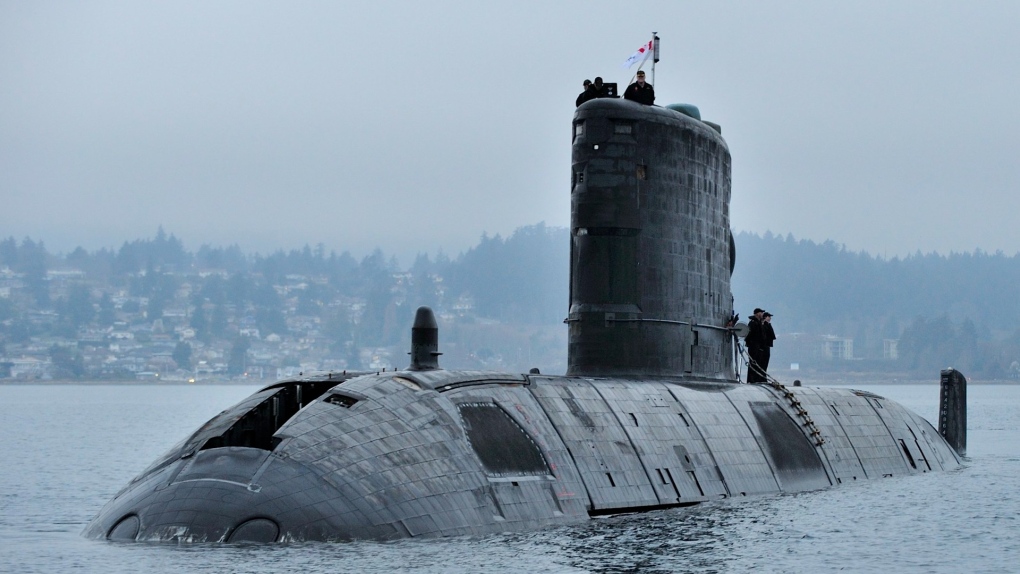Canada seeking new torpedo countermeasures for military submarines
 Her Majesty’s Canadian Ship (HMCS) Victoria returns home to Esquimalt, B.C., from operations with the United States Navy on February 26, 2015. (LS Zachariah Stopa/MARPAC Imaging Services)
Her Majesty’s Canadian Ship (HMCS) Victoria returns home to Esquimalt, B.C., from operations with the United States Navy on February 26, 2015. (LS Zachariah Stopa/MARPAC Imaging Services)
The Canadian navy is on the hunt for a new system to defeat hostile torpedoes as it works to extend the life of its four Victoria-class submarines through the mid-2030s.
In documents published last week, the Department of National Defence and Procurement Canada say advances in sonar technology and torpedo guidance systems have made anti-submarine torpedoes more effective than ever at overcoming decoys and other countermeasures.
Canada's military submarines currently use small, three-inch beacons that have to be manually loaded and launched from either end of the boat to counter a torpedo threat.
There are two types of beacons currently in use; one that creates enough electroacoustic noise to hide the submarine from sonar detection, and another that produces a flurry of false sonar targets in an attempt to exhaust a searching torpedo until it runs out of fuel.
The order to launch the decoys has to be given verbally from the sub's control room to the beacon operator, hindering the crew's ability to respond quickly.
"The lack of integration or remote-control functionality greatly reduces already limited reaction time, decreasing the prospect of surviving a torpedo attack," says Procurement Canada in its request for information from military suppliers.
The goal of the agency and the DND is to eventually provide Canada's four diesel-electric submarines with a launch system that is fitted to the submarine's external hull and can be triggered remotely, according to the request.
LONG-TERM MODERNIZATION PROJECT
Despite the current lack of integration and remote functionality, a National Defence spokesperson says the navy's existing anti-torpedo countermeasures "are adequate to fulfil today’s operational requirements."
"However, given the rapidly evolving technological landscape, an upgraded torpedo countermeasure launch capability project is being included as part of the broader Victoria-class modernization project," said spokesperson Andrew McKelvey.
The long-term submarine modernization project, valued at between $1 billion and $4.99 billion, is intended to extend the life of the submarines though the mid-2030s and is a cornerstone of Canada's defence policy.
The timeline for the torpedo countermeasure replacement project will be determined after the information-request period closes on Aug. 26, McKelvey said.
"Consulting industry early in the process helps establish contracts down the line with improved pricing structures, better definition of requirements, improved timelines and built-in consideration of procurement opportunities," the spokesperson said.
"It will also ensure that we receive the maximum number of bids that meet the necessary technical requirements."
Canada's military submarines are based at Canadian Forces Base Halifax and Canadian Forces Base Esquimalt. The subs can operate globally on deployments that typically last up to two months.
CTVNews.ca Top Stories

Trump promises a 25% tariff on products from Canada, Mexico
U.S. president-elect Donald Trump said on Monday that on his first day in office he would impose a 25 per cent tariff on all products from Mexico and Canada, and an additional 10 per cent tariff on goods from China, citing concerns over illegal immigration and the trade of illicit drugs.
'Devastating:' Ford warns of impact of new tariffs promised by Donald Trump
Ontario Premier Doug Ford is warning that Donald Trump’s promise to impose a 25 per cent tariff on goods arriving in the United States from Canada and Mexico could have a 'devastating' effect on the province’s economy.
Legault says Trump's 25 per cent tariff would pose 'huge risk' for Quebec, Canadian economies
Premier François Legault says President-elect Donald Trump's threat of a 25 per cent tariff on all imports would pose a 'huge risk' to the Quebec and Canadian economies.
Premiers seek 'urgent' meeting with Trudeau before Trump returns to White House
Canada's premiers are asking Prime Minister Justin Trudeau to hold an urgent first ministers' meeting ahead of the return to office of president-elect Donald Trump.
Here's how much Alberta exports to the United States
With the United States being Alberta’s top trade partner, sweeping 25 per cent tariffs proposed by President-Elect Donald Trump could have a major effect on the province’s economy.
'It's just not fair': Retirees speak out on being excluded from federal rebate cheques
Carol Sheaves of Moncton, N.B., says it's not fair that retirees like her won't get the government's newly proposed rebate cheques. Sheaves was among the seniors who expressed their frustrations to CTVNews.ca about not being eligible for the $250 government benefit.
NDP support for part of Liberal relief package in question, as House stalemate persists
After telling Canadians that New Democrats would back Prime Minister Justin Trudeau's holiday affordability package and help pass it quickly, NDP Leader Jagmeet Singh now wants it split up, as he's only ready to support part of it. Public Services Minister Jean-Yves Duclos said the Liberals are 'certainly open to working with the opposition parties,' to find a path forward.
Deer spotted wearing high-visibility safety jacket in Northern B.C.
Andrea Arnold is used to having to slow down to let deer cross the road in her Northern B.C. community. But this weekend she saw something that made her pull over and snap a photo.
Canadian Army corporal fined for stolen valour at Remembrance Day ceremony
A corporal in the Canadian Army has been fined $2,000 and given a severe reprimand for wearing service medals he didn't earn during a Remembrance Day ceremony in Alberta two years ago.

































